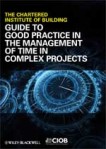The Chartered Institute of Building has launched its Project Time Management Qualification (PTMQ) framework upon which the CIOB will assess and accredit Project Time Management professionals placing CIOB at the forefront of establishing the premier industry standard in planning, scheduling and project control.
The first element of the framework, the Project Time Management Certificate (PTMC) was launched at a gala function in London, by the CIOB President last week. Unlike existing certifications, this qualification is focused on assessing the candidates knowledge of practical project time management. It is designed for new entrants to planning and scheduling as well as those who are already engaged in the management of time on projects. Holders of the PTMC will have demonstrated a rigorous understanding of the practice that underpins project planning and scheduling.
The launch of the PTMQ framework moves CIOB one step close to completing a five year strategy to provide standard education, training and accreditation in time management.
Back in 2008 CIOB research found that 67% of complex building projects were late. Of those delayed 13% were more than 3 months and 18% over 6 months. This finding prompted the CIOB to embark upon the development and publication in 2011 of the CIOB Guide to Good Practice in the Management of Time in Complex Projects which sets down the process and standards to be achieved in preparing and managing a time model.
The Guide underpins the new CIOB contract for the management of complex projects due for publication later this year, and the PTMQ framework for assessing and accrediting the Project Time Management professionals required as part of the CIOB contract.
The PTMC examination is open to CIOB members and non-members, those who have gone through Project Time Management training or those who have self-studied. It will appeal to anyone looking for a relevant and credible qualification in project time management. And in combination with the forthcoming Practitioner (PTMP) and Specialist (PTMS) credentials, it will offer a project time management qualification structure that will provide a progressive development path based on assessment of skills, knowledge and experience in planning, scheduling and project controls.
Mosaic is the exclusive CIOB partner for delivery of training in Australia and New Zealand, with rights to deliver training throughout the wider region. We are currently working on a planned series of public workshops and examinations commencing in Q1 of 2013. Courses and/or examinations can also be arranged for organised groups. For more information on this exciting development see: http://www.mosaicprojects.com.au/Training-CIOB-TM_Credential.html
UK and European readers contact: http://www.athenaprojectservices.com/





